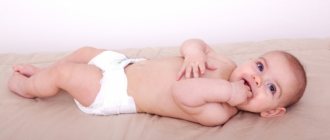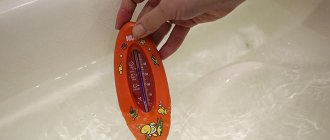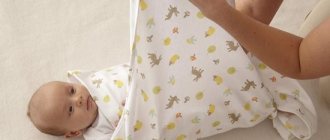How to properly put on a diaper for a boy and a girl
Content
Few expectant parents think about how to put diapers on their newborn baby.
Such actions seem to be a simple procedure that does not require special knowledge and skills. However, carrying out this seemingly simple operation has its own certain rules and nuances. The skin of newborn babies is tender and sensitive. She is susceptible to diaper rash and irritation, which can be prevented by using special cosmetics and timely changing of diapers. When putting a diaper on a child, special care must be taken so as not to damage the baby’s fragile, not yet fully formed body. At the same time, in order to put on a diaper correctly, one must take into account the anatomical differences between boys and girls.
Tips for moms
- Change your newborn's diaper promptly.
- Keep an eye on your baby's skin. If the baby's bottom is wet, then the diaper needs to be changed.
- It is ideal to change the diaper after each urination. Of course, most moms don't do this. Since such consumption of diapers can seriously affect the family budget. Therefore, the optimal time for changing a diaper between urinations is considered to be 4 hours.
- How to properly put on a diaper for a boy? To avoid problems with the fit of the product, try to choose diapers that match the baby’s size.
- When purchasing diapers, pay special attention to the integrity and tightness of the packaging.
- Each time you change a diaper, leave your newborn to lie naked for a while. Air baths help reduce the risk of diaper rash.
Preparing to put on diapers
A changing table can make changing a diaper very easy.
Before putting a diaper on your child, you should prepare a place for this process. In this capacity, you can use a special changing table, a sofa or a regular table. The main thing is that there is enough space not only to freely accommodate the baby, but also to conveniently carry out all procedures. The baby can spin and twirl. It is necessary to ensure that the baby cannot accidentally fall from the sofa or table.
The selected place should be covered with oilcloth, which will protect the surface from the baby’s secretions. Place a clean soft cloth or diaper on top. Children's hygiene products - creams, powder, wet wipes or a towel, as well as a clean diaper - should be located within reach. If the baby has defecated, before putting on the diaper, the baby should be washed and wiped dry. In cases where it is clean, it is enough to wipe it with wet wipes or a towel.
If a rash or irritation is found on the baby’s body, problem areas should be treated with an anti-inflammatory baby remedy. In any case, before putting the diaper on the baby's skin in the crotch area, apply a softening cream and wait a few minutes until it is absorbed into the skin. During this time, the child can be given a light massage of the arms, legs, and tummy to improve his blood circulation. In addition, affectionate and gentle tactile contacts with parents calm children and contribute to the normalization and harmonious development of their psyche.
Important rules for using diapers for a baby
- Redness of the skin
under the diaper can be caused by overheating. In this case, you should give your baby air baths more often and ventilate the room. Also, do not over-wrap your child in a warm room. - If the baby is sick
and has a high temperature, it is better to do without a diaper - it prevents the effective transfer of heat from the child’s body. If you absolutely cannot do without a diaper, then you should turn off the heaters and ventilate the room, creating a room temperature of no more than 18 degrees. - Pampers do not cause diaper dermatitis
. It is usually formed from the combination of urine and feces. Changing diapers in a timely manner eliminates such troubles.
Diapers have appeared in our lives for quite a long time, but the older generation does not always have enough experience to teach young parents how to properly put on a diaper for a newborn. And although many people now go to various courses to prepare for childbirth, it is one thing to put a diaper on a doll, and a completely different thing to put on your own baby.
How to properly put a diaper on a child: step-by-step instructions
Be sure to use powder - this will protect your baby’s skin from irritation.
After preparing the area, examining the baby and treating his skin with cream and powder, you can begin to put on a clean diaper:
- The diaper should be opened and straightened so that its surface with the pattern is on the bottom side.
- The child's legs, carefully holding them by the ankles, must be raised so that the child's butt rises slightly above the table surface.
- The unfolded diaper is placed under the baby’s buttocks and his legs are lowered.
- The upper part of the diaper is wrapped over the baby's stomach. If a newborn baby's belly button has not yet healed, you can use a diaper specially designed for such cases with a cutout in the front or tuck the edge of a standard diaper so that it does not injure the wound on the tummy.
- The Velcro located on the sides of the back of the diaper must be pulled towards you, pressed tightly and fixed in this position from the front of the product.
- After fixing the Velcro, you should check the tightness of the diaper to the baby’s body. The gap between them should be one finger thick. A tighter-fitting diaper will press, rub the skin, and cause discomfort in the child. If the diaper does not fit tightly enough, it may not absorb the baby's secretions well.
- All folds of the diaper you are wearing should be carefully straightened and smoothed out with your hands.
When changing diapers, it is recommended to adhere to the following rules:
- It’s easier to put diapers on a calm baby when he’s in a good mood;
- you should not wait until the reusable diaper becomes full of moisture from urination, the child feels discomfort and starts crying;
- It is advisable to change the diaper immediately after defecation, otherwise bowel movements can cause allergies in the baby and the development of microflora favorable to harmful bacteria;
- The optimal frequency for changing diapers is 3-4 hours; this requires more diaper consumption, but prevents diaper rash and irritation of the baby’s skin.
As an alternative and to save money, you can use reusable diapers or gauze diapers instead of diapers. However, such products will have to be changed more often; they must be washed, boiled and ironed to achieve sterility. In addition, they protect the child less well from the cold during winter walks, especially after the baby has bowel movements.
How to use diapers correctly
- Regardless of the type and model of diaper, always perform hygiene procedures during the change. Use only hypoallergenic cosmetics;
- Diapers are changed every time after the baby poops, or every two to four hours, regardless of how full the product is. Don't wait until the diaper is completely full. This will help avoid skin problems and keep the child in a good mood;
- Gauze diapers are replaced as they become wet and after each bowel movement. Products are thoroughly washed, dried and ironed;
- If gauze products turn yellow over time, soap the gauze with laundry soap and soak for several hours in a 3% solution of water and hydrogen. The solution is diluted in a ratio of two tablespoons of the product and five liters of water. After this, wash the product and rinse thoroughly. But be careful with laundry soap, as due to its alkali content it can cause irritation on the skin;
- The inserts in panties are changed up to ten times a day, and it is advisable to change the panties themselves once a day;
- If the skin under the diaper turns red, the baby is overheated. Remove the diaper and wash the baby;
- For irritation and rashes, you can use baby creams and lotions with chamomile, string, and celandine. But first make sure that the baby is not allergic to these components;
- Perform air baths regularly. The baby should not always be in diapers;
- Pediatricians recommend giving up diapers if your baby has a cold. At elevated temperatures and during illness, it is important to ensure natural heat transfer;
- Maintain a comfortable temperature and humidity in the children's room. The suitable room temperature is 18-22 degrees, and the humidity is no more than 70%;
- Don't forget to do gymnastics and
- Place the baby stomach up on the changing table.
- Make sure your butt is clean and dry.
- Remove the diaper from the package. Having opened, straighten the elastic bands and Velcro.
- Grasp the baby by both feet with one hand and carefully lift his legs along with his butt.
- Place the unfolded diaper under the butt, then lower it onto the diaper.
- Spread the upper half over the baby's belly. If there is an unhealed umbilical wound, the edge of the diaper should be folded back so that it does not rub against the wound.
- Having straightened the upper part of the diaper, secure it on both sides with Velcro.
- Check the tightness of the diaper to the baby's body. It should not hang loose or put too much pressure on the stomach.
How to properly put a diaper on a boy
A tight diaper will only cause inconvenience for your baby.
There is an opinion that for boys it is necessary to adhere to special rules when putting on diapers. For example, it is believed that his scrotum should be lifted up so that the diaper does not put pressure on the testicles. In reality, there is no point in doing this; the boy’s genitals will return to their original position after changing the diaper. Only a tightly tightened diaper brings discomfort to the baby.
There are also recommendations according to which the baby’s penis in a fastened diaper should be directed upward to avoid squeezing. However, pediatricians argue that this idea is also incorrect. The position of the genitals of a boy wearing a diaper does not affect his health in any way. Moreover, with the penis pointing upward, there is a risk of urine leakage, which can not only stain the child’s clothes, but also cause diaper rash and allergic reactions.
The boy's genitals can remain in their natural position while putting on and wearing the diaper. For his health and comfort, it is more important that the diaper matches the baby in size and is not fastened too tightly or loosely.
How to wear it correctly?
- Take one diaper and open it. You need to straighten all the Velcro and place it on the diaper with the wide part away from you.
- Now take the baby by the legs and lift his butt a little.
- Place the prepared product under the baby. The wide part should be under the butt, and the Velcro should be on the sides. The front part will be on top.
- Pull it up slightly so that the edges are aligned horizontally.
- We dress a newborn a little differently. His umbilical wound may not yet have healed, so turn the top edge of the diaper outward. Then he won't hurt her.
- Pull the Velcro a little and stick it to the rough front. Do this on both sides.
- You need to check that the elastic bands do not put too much pressure on your tummy. You should be able to insert your finger freely.
- To prevent anything from accidentally leaking, you need to straighten the rubber bands around the legs. They can also chafe and cause discomfort.
Watch the video:
- It is recommended to change diapers every 3 hours. This is not only due to hygiene reasons. The thing is that wearing them for a long time can cause overheating. As a result, the skin sweats and inflammation appears on it.
- Be wary of new brands. It is important to monitor for allergic reactions; the skin may be moist or chafed. If something does not suit you, then change this manufacturer.
- When the temperature rises, it is important to stop wearing diapers. They cover most of the surface of the baby's skin, which prevents free heat exchange.
- Always purchase diapers by weight. You should not buy them in reserve - your child can quickly grow out of them.
- There is no difference between putting diapers on a boy and a girl. Do not apply cream or powder to the genitals.
The nuances of changing diapers for girls
The health of the baby and the peace of mind of the mother depend on a conveniently worn diaper.
Due to the anatomical structure of girls, there are no special rules when putting diapers on them. Greater attention is required to maintain hygiene when changing diapers. For example, after defecation, girls need to be thoroughly washed. To prevent feces from getting on the genitals and thereby causing irritation to the delicate skin, washing movements should be made from the front to the back. In this case, natural vaginal lubrication should not be washed off, since it performs a protective function. To soften and moisturize the skin, the appropriate baby cream is applied to the girl only on the groin folds.
In general, according to pediatricians, the process of putting on a diaper does not depend on the gender of the child. However, there are diaper models that are designed separately for boys and girls. They differ in the location of the additional absorbent layer. For girls - in the central and back parts of the product. For boys - in the front, where there is also more free space for a comfortable position of the genitals. Such features make diapers more comfortable for children, but the main thing in maintaining their health is timely changing of diapers.
Diapers for girls and boys
Diapers for boys and girls have some differences. For girls, the absorbent material seal is located at the back and in the middle, and for boys - at the front. This is due to the structural features of the body and the need for rapid absorption in the right place. Although it is worth saying that most models are suitable for both boys and girls and are no different from each other. Manufacturers write the designations for whom the product is intended on the packaging itself.
A few tips before putting a diaper on your baby
Regardless of who needs to wear disposable panties, the algorithm of actions is the same. The only exception is diapers for older babies, in the form of panties. There is no need to fasten Velcro in such products, so it is more convenient to put them on when the child is standing. But when you need to take off your panties, then you will need to unfasten the Velcro for convenience.
Regardless of whether there is a clue as to who diapers are intended for or not, in order to use them as efficiently as possible, it is worth remembering some rules.
- Make sure the diaper is not pinching your organs. Pay attention to whether the diaper restricts the baby’s movements, as this can lead to chafing of the baby’s skin.
- It is recommended to change diapers every 2-3 hours. If the baby poops, then you need to change the diaper immediately. Otherwise, you risk skin irritation and diaper rash.
- Find a brand that suits your baby and don't change it. Often, irritation on the skin can occur due to the fact that the brand of diapers used is not suitable for the baby’s sensitive skin.
- Always use wipes, talcum powder or cream before putting on disposable panties, because your baby’s delicate skin always requires care.
- Give your baby air baths more often. This will give your skin a break from constant diaper use. At this time, you can give your baby a massage or exercise. Rest assured, he will be delighted.
- Don't let your child play with diapers. Frequent unfastening and fastening will damage the Velcro, and this will cause the product to lose its original quality. If you wear such a diaper, it may sag and leak.
- When at home, use a gauze diaper or allow your baby to be naked. In a cloth diaper, the baby's skin breathes, and this prevents diaper rash. In addition, by running without disposable panties, the child will learn to potty faster.
Gauze panties are shaped like a disposable diaper. They are used mainly at home or for a short time, so to speak, for safety net. Gauze diapers are not very popular among consumers. It's not as absorbent as its disposable counterpart, but it's a great way to potty train your little one. The good thing about a reusable diaper is that after washing it can be worn again, so its presence in your child’s wardrobe will help save you money. It is more convenient to put on gauze panties for older babies while standing, and for newborns – lying down.
Even if at first you see beads of sweat appearing when changing your baby’s clothes, change the diaper in a timely manner, do not wait until the baby begins to act up. Then this procedure will be pleasant for him, and he will not interfere with your actions. And remember, everything comes with experience.
Whether you use a reusable diaper or a disposable one, you need to wear both correctly. This will help you avoid various troubles in caring for your child and save your budget. And we told you how to do this.
Changing and putting on a diaper for a newborn is not difficult, and every parent will quickly and easily master this procedure. It is very important to follow the norms and rules of hygiene so that rashes, diaper rash and other troubles do not appear on the baby’s skin. In addition, it is important to choose the right diaper. It should be a comfortable product made of lightweight, breathable and hypoallergenic materials. Let's look at how to choose and how to properly put on a diaper for a newborn.
Why is it important to know how to change a diaper correctly?
After the baby is born, one of the main concerns of parents is changing diapers. Newborn babies often go to the toilet, so the comfort and health of the baby depends on the ability to quickly and accurately change a diaper. This is not difficult to do, but it is important to know a number of generally accepted recommendations designed to make this procedure easy and stress-free.
When should you change a diaper?
- Since a newborn baby relieves himself often, it is generally accepted that the diaper should be changed at least once every 4 hours. This rule is true even in cases where the diaper is not yet fully filled, because the baby’s skin must be regularly ventilated. A fresh diaper in any case provides better air flow than an already used one.
- Of course, regardless of time, the diaper should be changed after each full bowel movement. Fecal matter most irritates the child’s vulnerable skin, so in this case, delay is unacceptable.
- A new diaper will come in very handy before you put your baby to bed. It doesn’t matter whether we are talking about a night’s sleep or a short day’s sleep - a clean new diaper is the key to a sound and healthy sleep without the anxiety that irritation and itching brings to the child associated with an overfilled diaper.
- If you put a fresh diaper on your baby before a long trip, be it a walk or a shopping trip, you will get rid of many possible problems.
- The diaper must be changed if, during restless sleep, it has shifted and no longer fulfills its function. Also, the diaper is always changed if there is damage.
- An important point: newborn babies go to the toilet with different frequencies, so the number of diapers that will have to be used in one day is ultimately determined by the baby's parents.
As a rule, after a child turns six months old, he stops going to the toilet with the same intensity, and the procedure for changing the diaper becomes less frequent.
Which diaper to choose for a newborn
Today there are three types of diapers, including disposable diapers, reusable gauze and reusable panties. A gauze diaper is made independently from several layers of gauze, between which cotton wool is placed to increase absorbency. Such products are affordable, economical and convenient. They are lightweight and do not cause rashes, itching and redness on the skin, like some store-bought diapers. Therefore, gauze diapers become a real salvation for children with allergies.
But gauze products need to be washed, dried and ironed after use. In addition, gauze quickly gets wet, and changing the diaper is quite difficult. Therefore, many parents prefer classic disposable diapers, which are thrown away after each use.
Of course, this is not a cheap pleasure, but they are more convenient to use. It is important to choose a safe product made from natural, breathable materials that do not irritate the skin or cause an allergic reaction in the child. In addition, it is important to choose a model that is suitable for the baby’s age.
You can also use reusable diapers, which are panties with a replaceable insert. The inserts are changed regularly, but the panties remain on the child. This is a more economical option than disposable models. But in this case, it is also important to choose safe products made from natural materials. Cotton and flannel are great because they quickly absorb moisture and don't irritate the skin.
Experts advise using different types of diapers. Thus, reusable diaper panties are suitable for long night sleep, gauze products can be used for waking and playing at home. And disposable models are optimal for walking and leaving the house. For more information on how to choose the right diaper for newborns, see.
How to change a diaper correctly?
With some skill, changing a diaper becomes a simple and quick procedure. The main thing is to do everything consistently, following generally accepted recommendations.
Step 1. Prepare everything you need.
We need a new diaper, wipes, some warm water with baby soap, a towel, and powder or cream.
Step 2. Learn how to remove the diaper correctly.
To do this, you need to put the baby on his back, unfasten the used diaper, then take the baby by the legs with one hand and lift him up. We take out the diaper, carefully rolling it up to prevent the contents from leaking out.
Step 3. Remove dirt.
If the diaper is full, remove the dirt with a napkin. After this, wash the baby with warm water. If there is serious contamination, you should use baby soap, but you should remember that in order to maintain the natural balance of microflora, you should not overuse even the most gentle and safe soap. We dry the baby with a towel and leave him naked for a while so that the skin rests and ventilates.
If you have to do the diaper change procedure outside, you can get by with just wet wipes. Leaving a child naked, without a diaper, is only permissible during warm weather.
Step 4. Treat the baby's skin.
To do this, you can use classic powder, cream or special gel. If the child does not have skin problems and sweats a lot, then you should use powder. This is the most common option, which eliminates the occurrence of allergies and helps remove excess moisture. However, sometimes your baby's skin becomes dry and irritated. In these cases, it makes sense to use baby cream or special gel.
Step 5. Put on a new diaper.
Holding the child by the legs with one hand, we place a new diaper under his back with the other hand. Then we lower the legs and straighten all the Velcro and elastic bands. After this, we put the front part of the diaper on the baby and fasten the Velcro. It is important to check the position of the diaper elastic bands located between the legs - they should not curl inward - in this case, urine and feces may leak out.
Pediatrician advice
It is important to make the diaper changing procedure safe. Prepare all the necessary accessories in advance and never leave the child alone unattended - he may roll over and fall from the surface on which you are changing the diaper. We also must not forget that the umbilical wound in newborns is a very vulnerable place, so for babies under 6 months old, diapers should be used, the design of which takes this anatomical feature into account.
If there are general recommendations, the frequency of changing a newborn's diaper depends on the characteristics of the baby's body. How often this procedure needs to be done is determined by parents through experience. The skin care product that is suitable for a child’s skin is determined in the same way. Knowing all the nuances of this important procedure, parents quickly get used to it and deftly change diapers exactly at the right time.
Restrictions on the use of disposable diapers
- Place the child on the prepared table, back down. Unfasten the diaper and gently lift the baby slightly by the legs. Remove the used diaper;
- If the baby poops, the skin is washed with warm water and wiped with a soft towel or dry wipes;
- If the baby has not pooped, there is no need to wash the baby. It is enough to wipe the skin with wet baby wipes;
- Leave the child to lie for 5-10 minutes without a diaper so that the skin can breathe and receive a portion of air;
- While your baby is taking air baths, never leave him unattended! At this time, you can do light exercises or massage. Stroke your tummy, spread your arms to the sides, bend your knees. At the same time, constantly talk to the baby in a calm, gentle voice, you can use nursery rhymes;
- Then the skin is treated with powder or baby cream. They will eliminate dryness, redness and irritation, and prevent diaper rash;
- Take a new diaper, straighten the elastic bands and unfasten the fastener. Gently lift the baby's legs and place the diaper under the bottom;
- Straighten the material at the back and front, as well as the elastic bands. If the umbilical wound has not yet healed and you are using regular products without a cutout in the center, bend the middle of the product down so that the fabric does not rub the wound;
- Fasten the diaper and check if it is tight on the tummy. A finger should fit freely between the belt and the stomach. Check to see if your child's legs are being pulled down by the elastic band of the panties. Straighten out the folds;
- If the diaper is a little too big for your child, fasten the Velcro diagonally.
Despite the obvious ease of use of this hygiene product, do not forget about contraindications and individual tolerance, as well as possible allergic reactions. It is not recommended to wear a diaper if you have diseases of the external genitalia or if there are skin lesions where the body comes into contact with the product.
Also, one should not forget about the wishes of the ward himself.
If you follow a few simple recommendations, your child’s skin will not be irritated, and the baby will feel comfortable:
- First, you need to decide how often to change the diaper. Many inexperienced mothers change diapers only after they are full. It is better to do the procedure every two to three hours.
- Secondly, always use powder or cream. This will help not only protect the baby’s delicate skin from chafing, but also prevent diaper rash.
- Thirdly, try using gauze diapers at home and giving your newborn air baths - this will protect the skin from irritation.
- Fourthly, remember how many times a day you need to wash your baby. Everything is simple here: every time after waking up and before going to bed - be sure! If the child has had a bowel movement, it is also better to wash it rather than rub the bottom with wet wipes.
As you can see, there is nothing complicated about putting on a diaper for a newborn; the most important thing is calmness and focus on results.
Rules of use and replacement frequency
Young parents who are preparing for their first child must take care of a large number of things that the baby will need after birth. At home there should be a crib of suitable dimensions with soft protection inside, a bathtub in which the baby will need to be washed daily. In addition, you need to take care of your first-born’s wardrobe, buying only clothes made from natural materials and suitable for his age.
Choosing a diaper is the most important stage, because it is an essential product for a baby. The modern market offers a huge number of brands for children of different ages and genders. They have certain differences, which cannot always be known before purchasing the product. Since diapers are now quite expensive, you should be careful when choosing. It is important for a newborn to buy hypoallergenic and very soft diapers so that they do not cause allergies and do not interfere with the movement of the baby’s legs.
Once the procedure for choosing a suitable brand is completed, it is worth paying attention to the age range, which is most often calculated in kilograms gained by the baby. A separate line produces diapers for newborns, which you should buy first.
Not all parents know exactly how to understand when to change their child’s diaper, which causes most skin problems in the form of irritation, rashes and dermatitis. There is a basic rule that you should not keep your baby in a diaper for more than 4 hours, during which time it becomes quite full and bowel movements negatively affect the skin. As soon as the baby has passed the bed, it is necessary to change him immediately, without delay, because feces are especially dangerous for the delicate skin of a newborn.
Choice
All disposable diapers are designed for a particular weight of the baby. This fact should always be taken into account when purchasing a product. It is worth noting that diapers that are too small can squeeze the baby’s crotch. Over time, this leads to deformation of the body. If you purchased a very large size, the diaper may leak. This will happen due to the loose fit of the product to the skin.
Each diaper package shows the baby's weight. Use this information when choosing a product. Also, there are currently many manufacturing companies. Some of them produce products with mesh, others create a soft coating. Panties-diapers or standard hygiene products with Velcro – the choice is always up to the consumer. Try several options and you may find the right product.
So we figured out the question of how to put on a diaper for a boy. Now you can find information about what you need to consider when choosing a diaper for guys:
- The packaging of diapers must be marked “for boys”. These products are characterized by a certain type of sorbent that absorbs liquid.
- Pay attention to the size and purpose of the newborn's weight. They are indicated by numbers and may differ from one manufacturer to another. Therefore, before choosing size 2 or 3, read the information about what weight category they fit into.
- If the baby’s weight is in the intermediate range, then preference should be given to larger size products.
- Please note that diapers for boys should be “breathable”, as overheating can negatively affect men’s health. Moreover, when the product does not allow air to pass through, babies may experience diaper rash.
- If the baby is one year old, then you should think about changing diapers to panties, and also potty training the boy.
- Avoid diapers that are made with fragrances. The fact is that such materials can provoke allergic reactions on the delicate skin of a newborn.
How often should diapers be changed?
Each baby develops its own bowel movement routine, so there is no one diaper changing schedule that works for every baby. Over time, you will notice when your baby poops and pees most often, which will allow you to create a rough schedule for changing diapers. But even in a steady state, it is important to regularly check the condition of the diaper in order to accurately determine the optimal time for changing.
- Diapers need to be changed as soon as the baby has relieved himself. Prolonged contact of feces and urine with the skin will cause irritation. The sooner you change your diaper, the less likely you will be to get dermatitis.
- Changing the diaper should be done after a long walk, before and after sleep - every time you are unable to control the condition of the diaper for a long time.
To check whether your baby needs changing, check the condition of the skin and diaper. If you feel wetness, change the diaper. Another criterion for how full a diaper is is its weight. Even if the baby’s skin is dry, but the diaper has become noticeably heavier, you need to replace it with a new one.
Focus on the absorbency of the selected diapers. An infant up to six months produces from 300 to 500 ml of urine per day, and by one year the daily volume of urine increases to 750 ml. Taking into account these indicators and the amount of moisture that a diaper can absorb, you can roughly calculate the required number of diapers for each day.
How many diapers do you need?
The average consumption of diapers with constant use, according to reviews from mothers, is about 8 pieces per day (this is about 120 “diapers” per month). The frequency of changing these hygiene products varies depending on how often the newborn is fed breast milk (this determines how many times the baby will pee, since this happens during meals in the first month of life). The nature of your stool also affects how many diapers you need per day or month - your baby may suffer from or, conversely, be prone to diarrhea.
You can reduce the consumption of diapers if you dress your baby in these hygiene products only for walks and trips to the pediatrician. Many mothers save significantly on expensive disposable “diapers” by using gauze or flannel products during sleep, which can be washed and reused as often as necessary.
Over time, you will decide how many diapers your baby needs, how often they need to be changed, and when you can avoid using them to save money.
How to wear and change diapers correctly
Prepare everything you might need:
- new diaper,
- wet wipes or a container of warm water and cloth napkins, a towel,
- cream or powder
- toys.
Place these items near the changing table so as not to leave the baby lying alone for a second.
Place a thin mattress or folded blanket on the table so that changing clothes does not cause discomfort for the baby. Place a disposable diaper on top, covered with a cotton diaper. Only after this can the baby be placed face up on the changing table.
If the baby has successfully pooped, it is advisable to wash it with warm water. This can be done in the nursery using warm water and cotton wool, soft gauze or flannel, or running water in the bathroom. It is important to follow the direction from front to back when washing girls so that feces do not come into contact with the genitals. You don’t need to use soap for this type of washing, since with frequent use it only irritates the mucous membranes and dries out the skin.
If you do not find feces in the diaper , but the baby’s skin is damp to the touch, you can use water or simply wipe the baby’s skin with wet sanitary napkins. If the diaper and the baby’s skin are dry, there is no need to wash the baby at all.
Such air baths can last 10-15 minutes each time you change clothes, which will have a positive effect on skin health.
The last operation when changing a diaper is putting on a new diaper. So, how to wear a diaper correctly:
All that remains is to fasten the Velcro, they should be symmetrical. When wearing a diaper, you need to carefully straighten it so that the fringe on the elastic bands around the legs is on the outside. To understand how to change a diaper correctly, watch our instructional video.
Babies often experience irritation and diaper rash associated with wearing diapers. To combat them, you can not only reduce the intervals between changing clothes, but also use special hygiene products: powders or creams. They are applied to clean, dry skin before putting on a clean diaper. You can also choose diapers with special impregnation, which softens the baby's skin and prevents irritation.
Benefits of diapers
Disposable diapers are an indispensable hygiene product for babies. Modern parents find it difficult to imagine caring for their baby without this product. Many do not even believe that they once did not exist and children grew up exclusively in diapers. Using a baby diaper, mothers can avoid endless washing of baby clothes and can safely go for long walks, including during the cold season.
Choosing the right diaper can only be done by trial and error. There is no one universal diaper that would be suitable for all children due to the individuality of a person. After all, it is impossible to predict the reaction of a child’s skin. Before putting a diaper on a newborn, you should take into account that its choice is determined by the age of the little one. It is indicated on the product packaging. The smallest size is a diaper from 2 to 5 kg. A number of these products have their own advantages and differences - belts or elastic bands, thanks to which physiological fluid does not leak.
When should a newborn's diaper be changed?
Changing the diaper is required after each bowel movement. It’s quite easy to notice: the hygiene product looks heavy, and the baby’s skin underneath is a little moisturized. Also, the diaper is changed every 3-4 hours if there has been no bowel movement. Firstly, these products do not allow the baby's skin to breathe enough. Secondly, prolonged contact with feces causes an allergic reaction.
Of course, such frequent replacement increases the consumption of diapers, but this is done for the benefit of the baby. Air baths when the little one is lying naked, or diapers, which, unfortunately, have to be washed, but you don’t have to buy new ones, will help you save on the amount of consumable products - these are reusable care materials. By the way, babies feel more comfortable naked and in diapers. It is more convenient for parents to use diapers. But here it is important to understand that a smiling mother who is not killed by washing diapers is much more important for the baby than any difference in comfort for the bottom.
How many diapers do you need?
On average, the daily number of diapers is 8 pieces. This number is influenced by the number of bowel movements the baby has, as well as the amount of breast milk or formula he consumes (after all, this determines how many times the baby will pee and poop). It turns out that parents will need about 120 diapers per month. You can reduce the number of products and costs if you wear diapers for your baby only for walks, at night, or when going to the doctor.
You can also save on diapers if you replace them with gauze or flannel products. They are great for washing and can be used repeatedly. Diapers can also be replaced with eco-diapers, that is, reusable ones, for which special inserts are used. Both the first and second ones can be washed a certain number of times. These are more environmentally friendly products, so they are also very popular today. Although those parents who prefer to replace washing with communication with the child or relaxation still choose disposable diapers.
If now you are faced with the question of how many diapers your baby needs per day, week and month, then it can be considered temporary. Over time, you will be able to easily determine how many diapers your child needs, as well as how to put them on correctly.
We need to prepare!
Preparatory procedures are a necessary element of changing a diaper. To do this you should:
- Pediatricians recommend changing diapers every 3 hours. This way you can avoid your baby overheating and skin inflammation. But keep in mind that this will increase the daily consumption of diapers. However, this is the correct way to use diapers.
- Before you start putting a diaper on your baby, you should give him the opportunity to take air baths.
- It is necessary to monitor the reaction of the baby’s skin to a particular brand of product. Try to avoid inflammation: if the baby’s diaper does not fit, his skin may turn red or even break out in a rash. Just try products from another manufacturer.
- During the child's illness and fever, it would be right to refuse to use diapers, because they are often the cause of overheating.
- Diapers should be a little too big for the baby, but never too small. Buy diapers designed for a slightly heavier weight than your baby. Newborn babies grow very quickly, and there is a possibility that a month’s supply of “diapers” purchased at a discount can quickly become small.
Hello, young and expectant mothers! Olga Ramazanova is with you. Due to their inexperience, many women make serious mistakes in using disposable diapers. This leads to serious problems for our children: diaper rash, chafing and allergic reactions. To prevent this from happening to us, we will study in detail the question of how to put on a diaper.
Let's get straight to the point! First you need to prepare:
- To make the baby comfortable and soft, it is best to carry out hygiene procedures on a changing table or sofa. First you need to lay down an oilcloth and a diaper.
- Place all the necessary baby hygiene products nearby: cream or powder, wet wipes, clean diapers.
- If possible, you should wash your baby with warm water (if he pooped). Place it on the back of your hand and wash your butt over the sink with baby soap. The girl must be washed in a certain way - from bottom to top, in order to prevent infection of the genital tract. Use a clean towel to blot your butt and the folds between the legs.
- Then use powder or cream. Apply a small amount into the folds and lightly smear.
- It is advisable to leave a little time between changing clothes to allow the skin to breathe.
Some useful tips on how to properly put on a diaper for a newborn:
- Modern diapers can be used even for newborns. There are special models on the market with a cutout for the umbilical cord, but you can do without them in the first weeks. It is enough to tuck the front part of a regular diaper so that it does not affect the healing umbilical wound.
- If you notice that the diaper is filling or leaking quickly, your baby is likely ready to move up to the next diaper size. Leaks also happen if you don't wear it correctly or the outer waterproof layer is damaged.
- With age, babies become more and more restless, which complicates the dressing procedure for mothers who are forced to speed up their actions. To distract your baby's attention, hang a musical mobile above the changing table or give your child his favorite toy. You can also entertain your baby by reading funny rhymes or singing.
New mothers often don’t know how to put diapers on a boy, but there’s nothing difficult about it. The penis should be carefully cleaned and positioned towards the legs to prevent urine from leaking out through the top of the diaper. Boys often like to relieve themselves at the moment of changing clothes, so it is good to cover their penis with a diaper or diaper while the diaper is drying and preparing a clean diaper, so that you do not have to change clothes with the baby.
How to put on a gauze diaper and panties
You need to put on panty diapers in the same way as disposable ones. Prepare the changing table. First determine where the front of your panties is. There is usually a picture at the front. In addition, detailed instructions are always indicated on the product packaging. Raise your baby's legs and remove the used diaper or old panties. Replace the insert, treat the leather and carefully lift the legs again, put the product on. Straighten the material, elastics and folds around the legs.
Many parents use gauze diapers because they are affordable, economical and safe. In addition, such products are made independently. You can sew panties from gauze with a replaceable liner and wear them like regular diaper panties. However, traditional gauze diapers are wrapped around the baby. They do this in three ways:
- The gauze is rolled up in several layers. One edge is folded up and placed on the boy's front or on the girl's back. The remaining edge is passed between the legs and tied;
- The gauze is folded in half and diagonally to form a triangle. The baby is placed on top and the lower end of the material is passed between the legs. The side ends are placed on top of each other and tucked into the resulting belt;
- A square piece of gauze is folded across and lengthwise, the top corner is turned away to form a triangle. The material is turned from bottom to top and the free edge is folded several times. The crumbs are placed in the compacted middle, the lower end of the material is passed between the legs, and the sides are placed on top of each other and secured to the resulting belt.
How to properly put on a diaper for newborns and adults
The question of how to put on a diaper correctly is asked by people who have never done this before. The process is quite simple and does not take much time. But there are some nuances that need to be taken into account. Otherwise, the diaper may rub the skin, adhere poorly to the body, and even leak. Let's consider the features of the process for adults and children: boys, girls and newborns.
Diaper selection
It’s not enough to learn how to use diapers for adults; you also need to know how to choose them. There are several parameters to pay attention to.
Figure 2 - When choosing a diaper, it is important to consider several factors
- Material. It should be soft, hypoallergenic, hygroscopic, breathable. So-called breathable products resist the appearance of diaper rash. Only the outer layer should be waterproof.
- Availability of clamps. It is convenient to use Velcro, which allows you to secure the diaper more tightly to the body.
- Size. It does not affect the level of absorption, but determines the suitability of the products to the patient’s hips and waist. Large sizes should only be chosen for large or obese figures. Otherwise, urine and feces will leak onto the bedding.
- Filling indicator. The presence of a strip or inscription that changes color when the diaper is filled helps determine the need for replacement.
Figure 3 — Packaging of diapers for adults
- Floor. A woman needs flatter models of diapers, a man needs a special insert.
- Design features. They must be taken into account if diapers are used for incontinence. For active people, it is important that the product is invisible under clothing.
- Reliability. To eliminate the risk of leakage, it is better to use multi-layer products or with additional liners.
- Quantity per pack. Diapers can be sold in packs of 30 pcs. This is convenient if hygiene products need to be changed frequently. And it is profitable, since in large packs the cost per unit is always lower.
Important preparation procedures
Before you start changing diapers, you need to prepare all the supplies. Leaving a swaddled child alone to go get missing things is dangerous. Therefore, we prepare in advance:
- dry, clean diaper;
- wet wipes;
- a set of changeable clothes;
- diaper cream or baby powder;
- diaper;
- a towel or sheet for drying.
You need to spread a clean diaper on the changing table or bed in advance. If you want to leave your baby with a bare bottom for a while so that the skin can air out, lay an oilcloth underneath.
If redness or diaper rash appears on the skin, be sure to treat the surface with a drying cream.
You can improve the condition of a baby's skin by performing air baths. If you have time, prepare your favorite toys in advance and leave your baby without a diaper for 10-15 minutes.
How to put on a diaper correctly
When all preliminary procedures are completed, you can proceed directly to putting on a diaper. They do this in the following sequence:
- Place a clean diaper on the changing table or bed and lay your baby down.
- Prepare a clean diaper. Unfold it completely from its transport position.
- With one hand, gently grasp the child by both legs at the ankles. Lift it up so that your butt lifts slightly from the diaper.
- With your other hand, slide the back of the sanitary panties under your butt to waist level (the back is where the Velcro is). Release your baby's legs.
- Pull the product between your legs and gently spread it over your stomach.
- Holding the front part with one hand, with the other, pull and fasten the Velcro strips one after the other. Their tension should be such that a finger can pass under the product freely. If the gap is large, feces may leak. If small, the baby will experience discomfort.
- Smooth out all moisture-retaining edges and folds around the legs and lower back.
Note! A correctly worn diaper should be positioned symmetrically on the body. This can be easily controlled by the filling indicator or longitudinal seams. They should run parallel to the spine.
Features of putting on diapers for newborns
When dressing a baby in the first days of life, you need to be very careful with the umbilical cord. To injure her less, it is recommended to use special hygiene panties for newborns. They have a hole in the upper part that goes around the umbilical cord.
If for some reason you can’t find such diapers, you can get by with regular ones. But when you fasten them, turn the top edge inward. Thanks to this, the edge becomes lower and does not injure the umbilical area.
How to put on a diaper for boys
There are many opinions about the features of hygiene. Some mothers believe that the lowered testicles can be squeezed during restless sleep, so they lift them before fastening the Velcro. Others try to point the penis upward to avoid damaging it. But these aspirations do not find support among pediatricians. No matter how you try to position the genitals, they occupy a natural position.
The only important thing about hygiene is to use diapers designed for boys. They have a gel absorbent layer concentrated in the front part, which allows the baby to stay dry longer.
Features of putting on diapers for girls
The main difference lies in the preliminary hygiene of the genitals. When you wash your baby after defecation, it is better to direct the water stream from the abdomen and remove dirt using movements from front to back. This helps prevent stool from entering the vagina.
It is better to use special hygiene panties for girls. In them, the absorbent layer is concentrated in the lower and rear parts, which corresponds to the specific spreading of feces.
Putting on a diaper
- Open the product and straighten the gathers and folds on it, place it near the baby with the inside without drawings up and the narrow side towards you, the latter is the “front”.
- Take the baby by both ankles with one hand and slightly pull them up, the baby’s butt will rise.
- Insert the straightened diaper into the gap formed with the other hand, so that the newborn’s butt rests on the wide part of it, and the Velcro is on the sides of the baby.
- Pull the “front” of the diaper towards you and up, and then apply it to the newborn’s tummy and straighten it (if you still have one, turn the top edge of the “diaper” inward so that it does not touch it).
- Grab the Velcro strips and, pulling slightly until the diaper fits snugly, fasten them to the top front of the diaper on one side and the other.
- Check the tight fit of the product to the baby’s body - your finger should fit between them.
- Straighten the folds of the diaper around the newborn's legs, since the gathered elastic bands often rub the baby's delicate skin, and physiological fluids can leak through them.
- try to change “diapers” every 2-3 hours, even if they are not full, this way you will prevent the baby from overheating and his skin from becoming inflamed, although this will increase the consumption of diapers;
- between changing clothes, be sure to allow the newborn’s genitals to “breathe” as much as possible;
- monitor the reaction of your baby's skin to different brands of diapers to prevent different ones - if it turns red, is covered in a rash, is chafed or is always wet, try products from a different manufacturer;
- If the newborn is sick and has a fever, it is better to refrain from using “diapers” for the period of illness, as they can cause local overheating.
- do not buy diapers for future use - the baby grows very quickly, and a month’s supply of “diapers” purchased at a discount can quickly become too small for him.
I wanted to ask how to put a diaper on a boy. My mother-in-law says that a special technique is needed there, to raise something, lower something. I do not understand anything. I'm about to have a baby and I'm even starting to get scared to put on this diaper, in case I do something wrong. There is absolutely no information about this on the Internet. Help me figure it out, please!
Answers
Believe me, there are no special difficulties. When you have a boy, you will immediately understand: there is no need to lower or lift anything before using the diaper. Let it lie in its natural position. Modern diapers do not press down anything and do not require any special knowledge or mastery of application techniques. Concerns about the need for placement and the risk of squeezing the reproductive organs can only come to the mind of a person who has never used diapers. It is clear that if a child weighs 6 kg, and you bought diapers designed for children weighing 3 kg, it can be crushed, but no one has canceled the need to use brains.
Draw your mother-in-law's attention to the fact that the task of relatives is not at all to intimidate pregnant women, who are already intimidated by domestic healthcare. The experience of purchasing panties for your father-in-law cannot be transferred to diapers for your future baby.
Good day, dear readers! Today I want to tell you how to properly put on a diaper for a newborn. I had this desire for a reason: my husband and I were visiting, and I witnessed a comical scene, a young daddy trying to put a diaper on his son. He's kicking his legs, but dad still doesn't understand which side the Velcro should be on. In the end I had to help, but it was a lot of fun!
In fact, it’s only funny when there is an experienced mentor nearby who can help at any time. However, if you don’t have one, it’s better to replenish your knowledge base. If you use diapers incorrectly, you can harm your baby. There are frequent cases of pressure on the baby’s organs or irritation of the skin.
I suggest starting your training by choosing a diaper.
Progress moves forward, and with it more and more new household items are created. Diaper manufacturers strive to improve their product so that babies are as comfortable as possible in them.
Now there are diapers that need to be selected based on the gender of the child. Thus, the structure of panties for girls is characterized by compaction of the absorbent in the back and middle part of the diaper. For boys, the absorbent strip is located at the front.
Diapers are:
Diapers with Velcro are most suitable for a newborn. We will learn to put them on.
How to put on a diaper for an adult
Hygienic panties are used not only for children, but also for older people. They are worn by elderly people who have poor urinary control, bedridden patients or enuresis. The most difficult time to change diapers is when a person is bedridden. Therefore, let's consider this particular case. Actions must be performed in the following sequence:
- Turn the patient on his side and spread a diaper on the bed. It will help protect the sheet from contamination during processing.
- Place the patient back on his back. Unfasten the side Velcro strips and carefully roll the front of the diaper down. At the same time, make sure that the discharge remains inside.
- Place the patient on his side in a position with knees bent. Roll up and throw away dirty sanitary panties.
- Wash the dirt, treat the surface of the skin with antiseptic agents and apply talc or a special cream.
- Fully straighten the new diaper, smoothing out all wrinkles.
- Fold the diaper in half lengthwise and pass it between your legs. It is more convenient to do this in one movement from front to back, lifting the knee of the upper leg with the second hand.
- Straighten the back of the diaper well. Holding it with your hand, turn the person on his back.
- Align and straighten the front part. At the same time, make sure that there are no folds that can rub the body and cause discomfort.
- Pull the sides tightly and fasten the Velcro. First you need to fix the lower part, and then the upper.
For patients who walk on their feet, the principle of putting on a diaper remains the same. But for convenience, all actions can be performed while standing.
Following these recommendations makes the process of changing a diaper simple and quick. This increases the level of hygiene.
If you find an error, please select a piece of text and press Ctrl+Enter.
Recommendations for removing diapers
Changing a diaper involves removing the used one and putting on a new one. It is necessary to unfasten the fasteners on the back and turn them with the sticky side inward so as not to scratch the skin. The bottom edge needs to be pushed under the hips with the palm of your hand. Next, fold the front part. The patient is placed on his side and the used diaper is removed from behind. The product should only be removed and put on from the back to eliminate the risk of transferring bacteria.
Common mistakes when taking it on and off:
- failure to follow the step-by-step instructions on the packaging;
- incorrectly selected size;
- incorrect selection of absorbency level.
After you have removed the adult diaper, you need to perform hygienic treatment of the bedridden patient, only then can you put on a new one.











